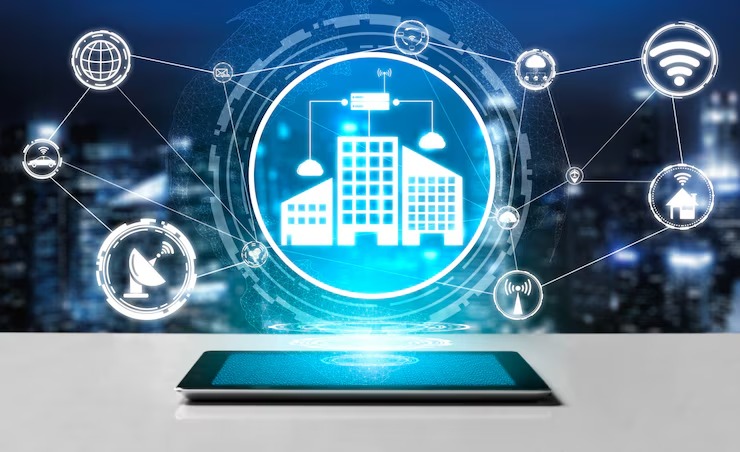IoT building management is a popular trend among commercial and residential property managers. They have realized that the Internet of Things eliminates the challenges of traditional building management, including slow response to crisis.
Since IoT connects many devices and supports their communication via the Internet, it helps property managers study different control systems at once. IoT resolves building management challenges by generating accurate insights that enable administrative and IT teams to decide and react quickly.
If you are a property manager handling commercial or residential buildings, you should know the benefits and challenges of incorporating IoT in your managerial strategy. This article reveals the IoT benefits, challenges, and trends.
Building Management via IoT Sensors
Building management is more efficient now, thanks to the innovative IoT sensors. These devices gather and convey data on the current conditions within a building. They measure various parameters, including humidity and temperature levels, water usage, air conditioning, lighting, electricity consumption, etc.

The IoT system transmits and delivers these data insights into a centralized building management system (BMS) using the Internet. Then, the IT and administrative teams use these insights to respond quickly and accurately. IoT building management sensors are of different kinds, including:
- Temperature sensors – These monitor changes in heating and cooling systems.
- Motion Sensors – They control the lighting and security needs of the building occupants.
- Humidity Sensors – The humidity IoT sensors manage indoor air quality to boost comfort and protect the occupant’s health.
- Air Quality Sensors – An air quality IoT sensor is an advanced measuring aid that detects carbon dioxide levels and other air contaminants within a habitable environment to increase the safety of the occupants.
- Light sensors – IoT light sensors detect the natural light changes and adjust artificial lighting fixtures accordingly. These sensors enable lights to turn on or off depending on occupancy, which helps to lower the electricity consumption rate.
IoT building management sensors automate your property, supporting real-time tracking and monitoring of crucial activities. They allow faster detection and eradication of crises before they worsen.
Benefits of Managing Buildings with IoT Technology
Smart buildings are spreading fast across the universe. These use IoT devices to use resources more economically while improving the occupants’ comfort and safety. An IoT building management system is beneficial in multiple ways, including:
- Saves Energy – Did you know that forty percent of global carbon dioxide emissions come from buildings? As a property manager, you can ensure zero CO2 emissions by 2050 via the IoT building management technique. IoT energy management allows you to adopt renewable energy sources to eliminate disruptions during an outage. These energy sources produce light from the sun or wind, making them cheaper options. Moreover, IoT light sensors can switch on the lights when the occupants are around and turn them off as they leave. Thus, these sensors can lower your utility bills by a huge margin.
- Optimizes HVAC Systems – Another primary benefit of IoT building management is that it enhances the performance of the HVAC system. Once you install IoT sensors to monitor temperature, humidity, and air quality levels, you can help your HVAC system update itself in real time. These sensors will generate real-time data insights and send them to the HVAC control system. It will adjust accordingly to enhance the occupants’ comfort without increasing energy consumption and cost.
- Improves Security – Building IoT devices is crucial when creating a secure office or home environment. These can detect strange activities or security violations and notify the IT team to react before a cyberthreat hits. Building managers can integrate IoT sensors with access controls to stop authorized people from entering a building or viewing the building management system. Furthermore, IoT can produce a live video feed and analytics if included as a surveillance camera feature. Internet of Things sensors can interact with crucial security appliances like alarms and CCTVs to create a seamless and robust network that can withstand threats.
- Enhances Operational Efficiency – IoT sensors can monitor the condition of building equipment to identify signs of damage before they trigger costly issues. It allows property managers to predict maintenance issues and take necessary measures to prevent sudden equipment failure. IoT can reduce operational downtimes and emergencies while prolonging the equipment’s life. Another way that IoT promotes operational efficiency is via task automation. It can automatically manage lighting, air conditioning, temperature, humidity, etc. This automation enhances operational efficiency by freeing your team members to do more productive work.
- Reduces Unutilized Space – IoT building management enables managers to allocate spaces wisely. The Internet of Things can analyze space utilization patterns within a building and expose unutilized or poorly utilized areas. Then, facility managers can use these updates to repurpose underutilized spaces and de-clutter overcrowded areas.
Challenges of IoT Building Management System
IoT building management integration is one of the most challenging IT activities you can do as a property manager. If you want to experience the benefits of IoT, however, you should first overcome the following challenges:
- High Deployment Cost – Establishing an IoT building management infrastructure attracts a high initial cost. The work entails the installation of different IoT sensors and creating an IT infrastructure solution that can support them. Even if the initial deployment cost is high for property managers with fewer resources, the project will recover every penny in the long run. Financial returns are possible because the IoT based building management system offers many assured benefits.
- Data Privacy and Security Breaches – The main task of IoT sensors is to monitor and gather real-time data. If you cannot protect this data from unauthorized access or a security breach, you might lose it to a malicious person. Enacting robust data privacy and security policies is challenging but unavoidable. The IT team should establish the correct data encryption method and the most secure way to transmit it. It should perform security audits to expose cybersecurity risks. Lastly, you must comply with privacy regulations to safeguard your occupants’ rights and avoid unnecessary litigations.
- Legacy Systems – Some houses still have legacy building management systems. These require upgrading to accept the IoT building management sensors. Significant building modifications can consume a lot of money, and you need the assistance of technology experts. Besides, creating a detailed integration plan for your legacy BMS is hard.

Future Trends of the Internet of Things in Building Management
The IoT building management is a trend that is about to go nowhere. Consider the integration of the ever-evolving IoT sensors with building management systems as a humble beginning. You should expect genius AI algorithms to emerge soon. These will interpret tons of IoT sensor data to generate their patterns.
They will also predict equipment maintenance times via machine learning (ML) techniques.
The machine learning models will study the sensor data until they learn to predict machine failures and estimate maintenance costs. This will happen without interrupting the smooth running of the building systems.
Another IoT building management trend to expect in the future is blockchain technology. Experts might use blockchain technology to manage and secure IoT sensor data. The technology will support a decentralized data storage method that will reduce the danger of data security breaches.
These future technology trends will further increase the efficiency and sustainability of IoT-supported building management systems. They will increase financial savings due to reduced energy costs and predictable building equipment maintenance overheads. The future IoT building management trends will improve security protocols, benefiting the occupants and their assets.
Final Thoughts
Property managers should consider creating smart buildings with IoT technologies. The IoT building management system is challenging to deploy initially due to the high cost. However, BMS managers should bear the hefty price because the IoT system will gradually recover the money. The IoT sensors generate real-time data on various control systems, enabling BMS managers to make more constructive decisions.





